Tensile testing of textiles provides strength and elongation properties for natural and man-made materials such as cotton, carbon, polyester, nylon, glass and graphite. Textiles can be tensile tested in many forms, including single strands, yarns, webbing, woven and braided materials, and nonwovens. Most textile fabric tensile tests are performed as grip tests in an effort to eliminate edge effects, or as strip tests that include edge effects. For grip testing, the fixture uses jaws smaller than the width of the sample to hold the fabric sample in the center. For the strip test, the fixture clamps a fabric using jaws wider than the sample width. For both tests, the sample is clamped inside the end of the sample length. Machines used for textile tensile testing are typically low force, high elongation, constant elongation or load, tabletop systems. Although the test machine seems to be the most important factor in testing flexible materials, fixture and jig movement must be considered.
When testing webbing or fabric-based products, it is important to rotate freely at one of the fixture holders to ensure that the fixture is in the plane of the textile for the duration of the test. Test jigs and fixtures must be determined by the specific type of textile being tested, and fixture requirements will be described in the standard if the material is tested in accordance with the test standard.ASTM and ISO specify the test methods and requirements for testing textile materials. Due to the wide variety of textile materials, a single tensile test method cannot address all the variations needed to properly test different textiles.
Popular ASTM tensile testing standards for textiles are:
ISO13934 Fabric grip and peel test tester
ASTMD76 Textile Tensile Testing Machine
ASTMD751 Coated Fabric Raincoat Testing Equipment
ASTMD1683 Stitching of Woven Fabrics
ASTMD4964 Tension and Elongation of Elastic Fabrics
ASTMD5034 Textile Fabric Grip Test
ASTMD5035 Break Force and Elongation of Strip Method Textile Fabrics
ASTMD6775 Testing Equipment for Breaking Strength and Elongation of Textile Webbing, Tapes and Woven Materials
ASTMD7269 Tensile Testing of Aramid Yarns
ASTMD76 specifies the requirements for the most widely used textile tensile testing machines, including Constant Elongation Rate (CRE) and Constant Force or Load Rate (CRL) machines.
Fabric tensile strength can be tested using universal tensile strength testing equipment with suitable sample mounting jaws.
There are several methods for tensile testing of fabrics, as follows:
Method 1:Peel test (British Standard)
Method 2:Gripping Test (American Standard)
Method 1:Peel Test
There are two types of peel tests. Cut strip test and split strip test.
1.Cut strip test.
It is suitable for fabrics with more filling, woven fabrics that cannot be unraveled easily, felted fabrics and nonwoven fabrics. For fabrics that cannot be unraveled like yarn, this procedure is not recommended because the edges are easily unraveled during the test.
2. Strip splitting test.
The strip splitting procedure is used to determine the force required to break a specific width of fabric. The split strip test is applicable to woven fabrics, while the cut strip test is applicable to nonwoven and impregnated or coated fabrics.
3. Test paper sample preparation.
5 warp direction samples
5 weft direction samples are first taken as a (60mmx300)mm sample and then ground to (50mmx300)mm
Test procedure:
Samples are clamped in the jaws of a microcomputer tensile testing machine. 500mm per minute of CRE loading. The scale length is 200 mm. After the test is completed, the result is displayed in the control unit; note this reading. Repeat the test for all other warp and weft specimens. The average value is obtained and the results are expressed in warp and weft mode respectively. Test result: Average breaking force Average elongation at break
Method 2:Grab test
This method is used to determine the effective breaking strength and elongation of woven, nonwoven and felted fabrics using the constant elongation principle. This test method is not recommended for glass fabrics, knitted fabrics and other textile fabrics with an elongation of more than 11%. There are two types of test methods to determine grip strength. They are the grip test modified grip test These two test methods are similar, but require smaller changes during sample preparation.
Testing Instruments.
Universal Tensile Strength Tester
Sampling.
Sample size: 100x1500mm
Jaw width-25mm
Marking distance-75mm
Test procedure: the sample is clamped between the jaws. Set the parameters for the corresponding test in the instrument. Adjust the speed so that the sample is broken within 20±3 seconds. Repeat the test for all other warp and weft specimens. Find the average value and the results are expressed as warp and weft way respectively. Test results: Average breaking force. Average elongation at break.




评论
发表评论